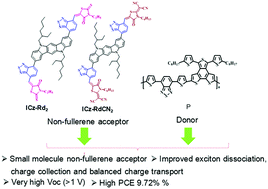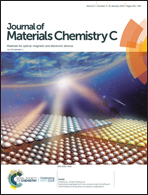New indolo carbazole-based non-fullerene n-type semiconductors for organic solar cell applications†
Abstract
In this work, two new indolo-[3,2-b]-carbazole (ICz) core-based non-fullerene acceptors (ICz-Rd2 and ICz-RdCN2) with an A–π–D–π–A backbone were designed, synthesized, and characterized and the influence of molecular engineering on the terminal end groups on their performance in organic solar cells (OSCs) was systematically examined. The ICz-Rd2 and ICz-RdCN2 acceptors showed strong and wide-ranging absorption profiles from 350–800 nm in solution and film with high molar extinction coefficients of 6.6 × 104 M−1 cm−1 and 1.0 × 105 M−1 cm−1, respectively. These acceptors were employed along with a low band gap D–A conjugated polymer P as a donor for polymer solar cells and, after optimization of the active layers, the P:ICz-Rd2- and P:ICz-RdCN2-based devices offered overall power conversion efficiencies of 7.88% and 9.76%, which are higher than that of their PC71BM-processed counterpart (5.89%). The enhanced power conversion efficiencies for these non-fullerene acceptors may be related to the wide absorption spectra of the active layers and their low voltage loss.



 Please wait while we load your content...
Please wait while we load your content...